Renderings on display at Chicago Architecture Center as part of a new exhibit titled ‘The New Magnificent: Visions To Renew And Reconnect The Mag Mile’
Lamar Johnson Collaborative (LJC), a full-service architecture firm based in Chicago, has announced a transformative vision for Michigan Avenue’s “Magnificent Mile” retail corridor in downtown Chicago.
Known as MM2050, the LJC plan was commissioned by the Magnificent Mile Association to explore innovative solutions for addressing vacancies spurred by the pandemic and ensure that Michigan Avenue remains a top destination and economic driver for Chicago. LJC created a series of conceptual renderings, guided by four design pillars: people, place, technology and experience, that showcase bold ideas for enhancing public spaces, improving pedestrian connectivity and encouraging sustainable, mixed-use development.
“Our comprehensive re-visioning of Michigan Avenue is the product of collaborative meetings with local stakeholders and data-informed studies to understand existing conditions, identify areas for improvement and anticipate future trends,” said Lesley Roth, Principal Urban Planner and Designer at Lamar Johnson Collaborative. “The strategy was to not only foster new economic vitality into the area but also ensure any improvements made on Michigan Avenue prioritized the public interest.”
The MM2050 renderings are currently on display at the Chicago Architecture Center as part of a newly launched exhibition titled The New Magnificent: Visions To Renew And Reconnect The Mag Mile.
LJC’s vision for the Mag Mile focuses on four points of improvement – or nuclei – along the mile-long corridor, each reimagined to evaluate experience and invite fresh investment:
- Riverfront Gateway: At the Mag Mile’s southern gateway, the plan calls for improvements around the Michigan Avenue Bridge, such as a new stairway leading to the river’s edge, a new boat dock and the reimagining of Pioneer Court. New cantilevered pedestrian bump-outs on the bridge give the feeling of floating over the water and provide opportunities for pedestrians to stop on the bridge and enjoy the views along the river without blocking foot traffic. “As a point of transition between the Loop and the Mag Mile, we focused on the Michigan Avenue Bridge gateway in our revisioning,” said Roth. “Taking a cue from how it is being used now – as one of the most iconic spots for viewing the skyline as well as the gateway to all the corridor has to offer – we’ve redesigned the bridge as a destination in itself.”
- Oak Street Beach Connector: At Michigan Avenue’s northern terminus, LJC envisions a new pedestrian bridge directly linking the corridor to Chicago Lakefront Trail and an improved Oak Street Beach, featuring new green space, seating and opportunities for diverse programming. The plan prioritizes accessibility and safety, making it easier for everyone to enjoy the shores of Lake Michigan. This important connector coordinates with the new Lake Shore Drive alignment.
- The Hub: To enhance the pedestrian environment along Michigan Avenue, the MM2050 plan focuses on widening sidewalks and creating cafe zones and places to relax within a dynamic urban setting. A planted median lined with shade trees creates an inviting atmosphere while dedicated bus and electric vehicle lanes improve safety and accessibility and streamline traffic flow.
- Urban Oasis: A reimagined Jane Byrne Park transforms the area surrounding the historic Chicago Water Tower into an urban oasis, and includes a reflecting fountain, tiered event seating, tree grove, plantings and public art. Wider sidewalks and space for food trucks prioritize pedestrians and opportunities to bring culinary offerings and other programming to the plaza. “There is something special and very ‘Chicago’ about referencing the historic Water Tower, one of just a handful of buildings to survive the Great Fire of 1871, and reinventing it as an oasis for Chicagoans and visitors,” said Roth.
“The Magnificent Mile is Chicago’s premier commercial corridor, and we have an opportunity to reimagine it as a ‘third place’ where all Chicagoans can not only shop but also relax, linger, dine, and enjoy new open spaces, cultural attractions and experiential entertainment,” added Roth. “Partnering with the Chicago Architecture Center to share MM2050 with the public helps continue this important dialog regarding the Mag Mile’s future, one which we think will be brighter than ever with a transformation that honors the potential for this corridor to continue its legacy as one of the great global destinations.”
The New Magnificent exhibition is included with admission to the Chicago Architecture Center at 111 E. Wacker Dr., steps from where Michigan Avenue meets the Chicago River. The exhibit is a part of The CAC’s Loop as Lab: Reshaping Downtowns initiative, which explores post-pandemic ideas for revitalizing Chicago’s greater central business district by diversifying uses and making the Loop more welcoming. The Lamar Johnson Collaborative designs are one of two concepts from architectural firms on display at the CAC’s exhibit.
About Lamar Johnson Collaborative:
Lamar Johnson Collaborative (LJC) is a Chicago-based full-service design and architecture firm that provides integrated delivery and full turnkey solutions across multiple industries. LJC’s services include architecture, interior design, landscape architecture, planning and urban design, sustainability and technical/quality assurance. The company is a wholly owned subsidiary of Clayco, a full-service, real estate, architecture, engineering, design-build and construction firm. Though LJC works closely with companies in the Clayco family of brands, more than half of its business is with outside developers and general contractors.
Click HERE to view additional photos and captions that accompany this story, including “before” images of the Magnificent Mile.
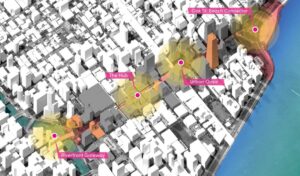
Mag Mile Overview Diagram_MM2050_Credit Lamar Johnson Collaborative: An overhead diagram of Michigan Avenue’s Magnificent Mile illustrates the four points of improvement (or nuclei) along the corridor reimagined by the MM2050 plan from architecture firm Lamar Johnson Collaborative.
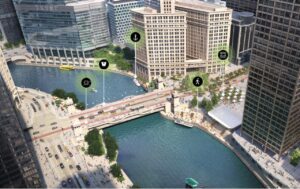
Riverfront Gateway_MM2050_Credit Lamar Johnson Collaborative: LJC’s MM2050 vision for the Michigan Avenue Bridge and surrounding area enhances pedestrian comfort with cantilevered walkways, a grand staircase down to the river, a new boat dock and improved connectivity between the Loop and the Magnificent Mile.
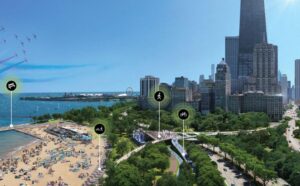
Oak Street Beach Connector_MM2050_Credit Lamar Johnson Collaborative: A proposed pedestrian bridge crossing DuSable Lake Shore Drive will enhance accessibility, programming and safety by linking Michigan Avenue to Oak Street Beach and the Chicago Lakefront Trail.
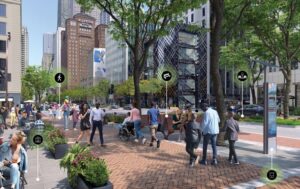
The Hub_MM2050_Credit Lamar Johnson Collaborative: Streetscape improvements to Michigan Avenue include widened sidewalks, a shaded median, dedicated cafe zones and bus/EV lanes to enhance the pedestrian experience, safety and traffic flow.
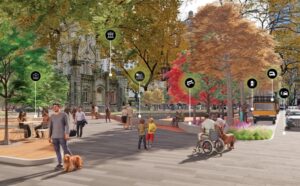
Urban Oasis_MM2050_Credit Lamar Johnson Collaborative: A new reflecting fountain, event seating, tree grove, public art and food trucks transform the space around the historic Chicago Water Tower into what LJC envisions as a new Urban Oasis along the Magnificent Mile.
